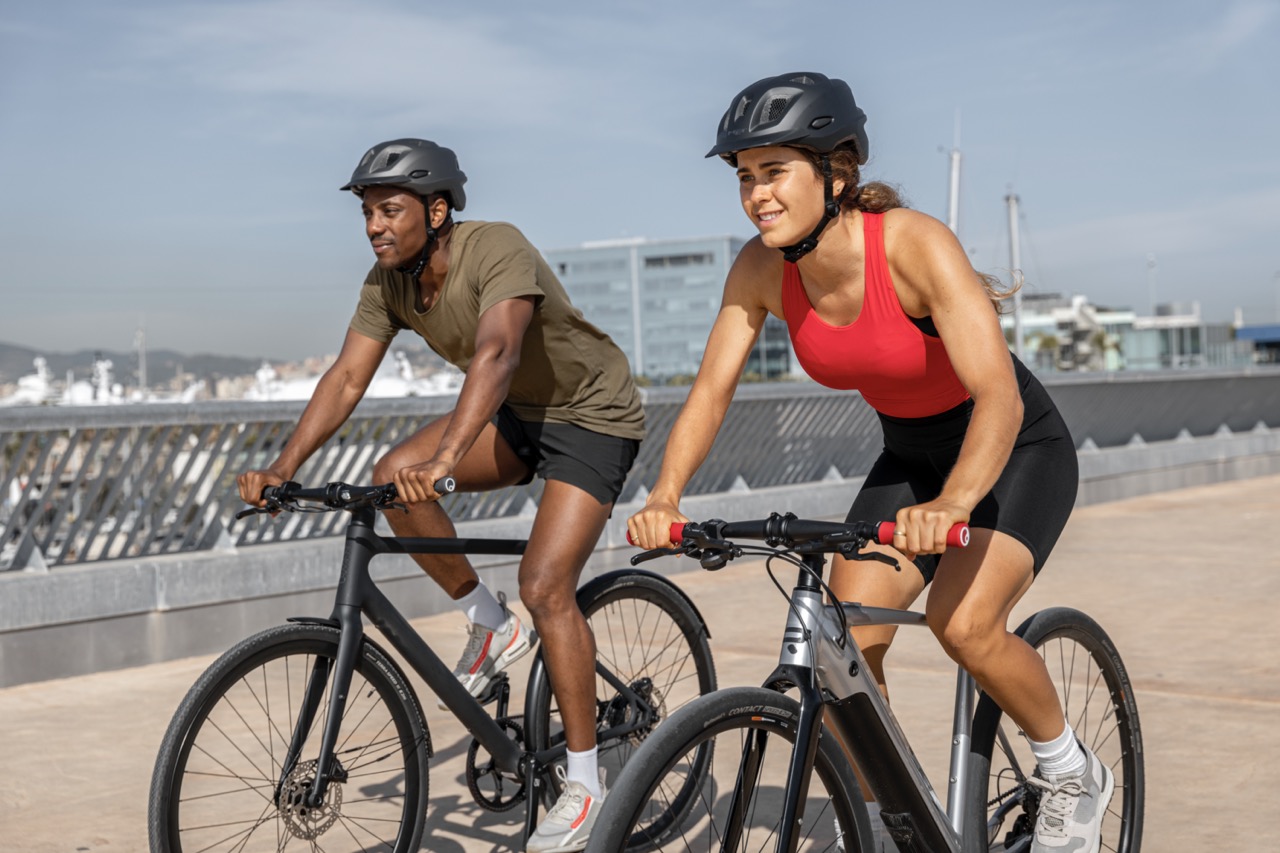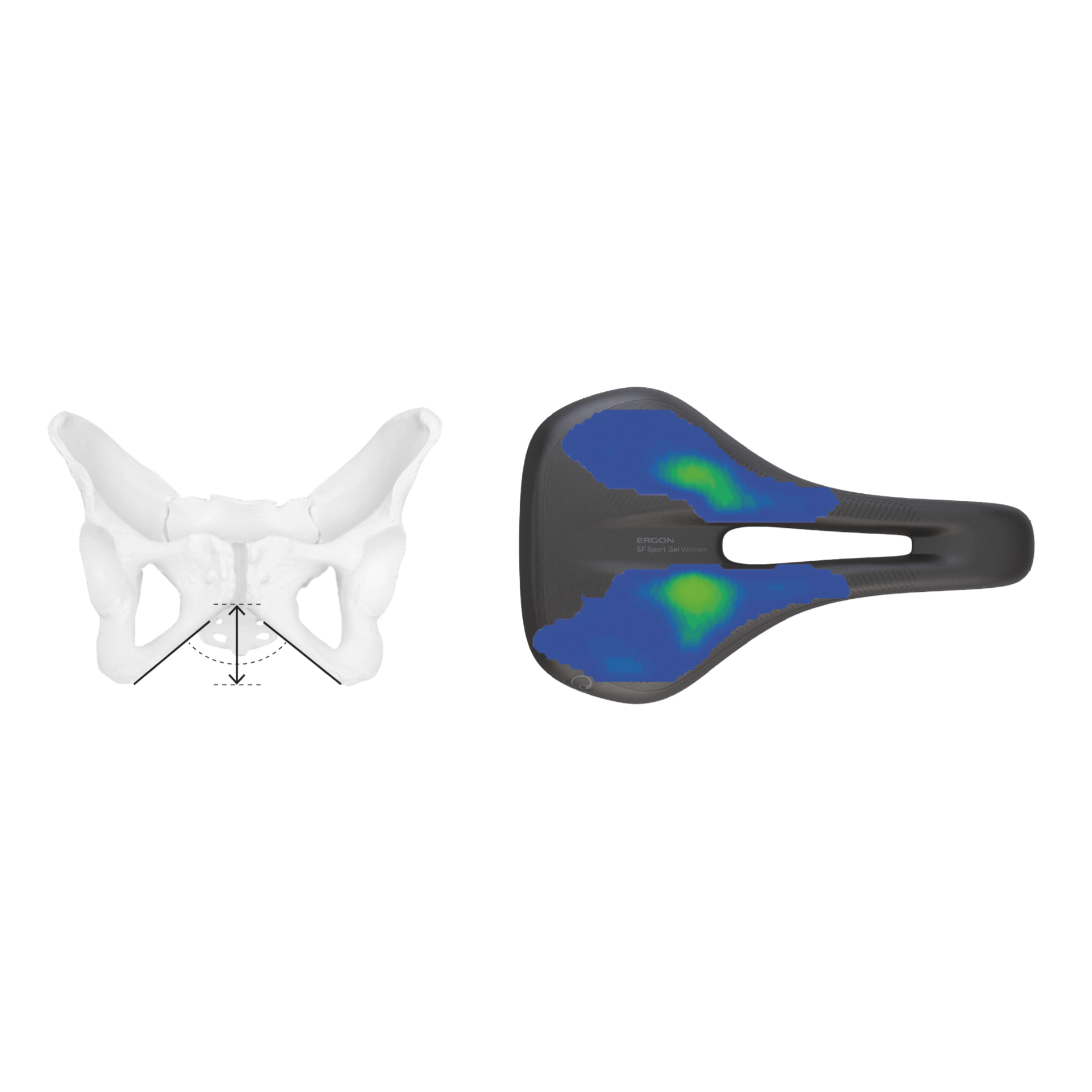Pubic Arch Pain While Cycling – Causes and Measures

Discomfort on the bike saddle is not the same as discomfort on the bike. Seat problems and pain can stem from skin friction or too much localized pressure. They also come from incorrect saddle shapes that place unnatural pressure on the sit and pubic bones at unsuitable points. This can lead to pain and even irritation of the bone, up to inflammation, especially on long days on the bike.
Pubic Arch Pain While Cycling
The sit bones and pubic bone are two of the five fused pelvic bones that come into contact with the saddle either individually or together while cycling. They each form the lower third of the socket for the hip joint. The right and left sit bones – lat. os ischium forms the two sit bone tuberosities, which can be easily felt through the skin at the underside of the gluteal muscle or when sitting on hard surfaces. They are arches running downward from the hip joints. The two pubic bones – lat. os pubis – also run in an arch towards each other. They orient forward and slightly upward when standing until they meet at the so-called pubic symphysis, a cartilaginous, not fully bony connection. This is located just above the crotch and is held together by strong ligaments. This residual mobility is significant during childbirth, where the pelvis expands to provide enough space for the fetus.

Pressure Pain in the Pubic Bone – A Woman's Problem?
Women's pubic bones are also more forward and outward curved because of their ability to give birth—good for childbirth, but unfortunately, a small anatomical disadvantage when cycling. The two pubic branches form a wider but flatter pubic arch in women. This is the lower edge of the two pubic bones, a rounded, upside-down "V" below the mentioned pubic symphysis.
Sitting on a chair makes no difference; women and men mainly rest their weight on the sit bones. These are relatively insensitive to pressure points. In the sitting position on the bike, with the back tilted more or less forward depending on the discipline, the pressure on the seat surface shifts towards the pubic arch. This is hardly the case on a city bike, but very much so on a triathlon bike. In addition to the type of bike, the saddle height, saddle shape, and the gender of the rider also play a role. While men with a flattening upper body angle tend to have problems in the genital area up to numbness, women tend to have painful spots on the pubic arch and the soft tissues in the intimate area, leading to seat problems. Even the sensitive rear perineal area plays a subordinate role here, primarily if the rider uses high-quality cycling shorts and perhaps a seat cream for relief. The pressure on the pubic bone, however, is not noticeably alleviated by such measures.
Click here for expert saddle and seat ergonomics knowledge, including 3-D models and pressure distribution graphics!
Pull and Pressure on the Pubic Arch
The body weight rests on the pelvis when standing, walking, and running. The thigh bones mainly transfer it to the iliac bones, which form the upper part of the hip joint socket. The two extensions of the pubic bones normally do not experience pressure from below. Only on a longitudinal beam, horse saddle, or bicycle saddle does weight rest on the pubic arch; the more one leans forward, the more the pressure shifts. Considering the sporty posture in a triathlon or on a racing bike, most riders experience overloads, discomfort, and seat problems, especially in the perineal and intimate areas.
The Small, Painful Difference
This pressure shift towards the pubic bone depends on the sporty sitting position and changes significantly with the gender of the person in the saddle. The great advantage of women in bending towards the handlebars, being on average more flexible than men, somewhat becomes a disadvantage in this context. Ligaments with more elasticity and less massive holding muscles between the back and pelvis cause women's hips to tilt towards the saddle nose more than men's. As a result, men tend to experience pain in the lower back and sit bones. At the same time, women much more often suffer from pressure pain along the pubic arch, up to the pubic symphysis, and surrounding areas in a very sporty posture.

The female pubic arch is also flatter, and the "V" is more of a wave. For possible childbirth, the two female pubic bones also extend further forward and outward. The contact of their sensitive parts with the seat surface occurs much sooner when leaning forward than in men. One can imagine it as if a person with a thick belly bends forward, their upper body touches their thighs much sooner than someone with a slim figure. The pressure pattern of a woman on the saddle is therefore further forward or extended forward compared to the average man. In men, it is more concentrated on the sit bones.

„The combination of pelvic anatomy, greater flexibility, and on average lower holding forces at the hip shifts the pressure distribution in women so far forward that even well-thought-out standard saddles offer completely wrong relief zones.“

More Than Just Pressure Pain
Due to the broader and flatter pubic arch in women, the contact points with the saddle generally lie somewhat outward, which can result in them not finding enough space on the horizontal saddle surface with standard models, but rather lying next to it, even with a nominally large saddle width. The body weight then rests on the upward sloping parts towards the pubic symphysis, with the tendency to push them outward instead of upward. As mentioned, the connection of the two pubic halves is not bony but forms a symphysis, a theoretically movable connection held together only by tight ligaments. Pubic bone pain while cycling combines pressure from below and pulls outward. Relief only occurs when the saddle shape and corresponding channels in the padding are adapted to the described anatomy.
From Pressure Pattern to Saddle Shape
What do all these differences between men and women mean regarding the saddle and its shape? Different ones are needed. The difference between functional saddles for men and women lies less in the saddle width at the rear, as is often propagated, but rather in shaping the saddle middle and nose. At Ergon, it is not the case that there is a standard saddle and a generally wider women's model, but both variants have been specially developed for the respective gender and their needs. Almost all saddles in the entire range are divided into men's and women's models.

„Women not only show a forward-shifted but overall larger pressure pattern on the saddle. Therefore, our Ergon saddles are slightly wider in the transition area to comfortably accommodate both the sit bones and the pubic bone. High-quality orthopedic padding materials help with this. The relief channel is also adapted to the female anatomy; due to the forward-rotated pelvis, it extends to the saddle tip and is wide enough for the soft tissues.“
What Can I Do About Pubic Arch Pain?
To reduce the painful pressure between the pubic bone and the saddle, one could either tilt the pelvis backward by changing the sitting position, but this quickly leads to new problems instead of solving the existing one. A better and more sustainable solution is to replace the saddle with an ergonomically adapted model for the body and gender. Alternatively, stretching and strengthening exercises can also correct the angle of the pelvis to the saddle, but this is more of a long-term solution. Adjusting the saddle tilt and setback, or significantly raising the handlebars to shift the pressure pattern towards the sit bones, can dramatically affect the power transfer when pedaling and/or bike control. Before taking such drastic measures, searching for a saddle that fits as perfectly as possible is worth it. The goal must be to position both the bony contact points – the sit bones and pubic arch – and the soft tissues on the saddle profile to avoid specific pain points. The pressure cannot be eliminated. It can only be redistributed to a homogeneous pressure pattern without pressure points through the right saddle, dynamic sitting, and occasional standing up. The soft tissues should be relieved or, even better, spared.
What Can Happen If I Ignore Pubic Bone Pain?
The worst that can happen: You could lose the joy of cycling. Therefore, seat discomfort should not be ignored, because constant pressure can lead to long-term problems. Irritation can become a permanent pain, like any bone exposed to unusual pressure and friction. This would mean a few weeks off from cycling. Since the genitals, the most sensitive organs in the body, lie behind and under the pubic bone, it is also the task of a good saddle to position them so that they are not pressed between the pubic arch and the saddle cover.
The consequences of saddle shapes that exert horizontal tensile stress on the left and right pubic bones, as described above, are also very unpleasant. If this tension is strong and long-lasting, it can, in rare cases, lead to a loosening of the symphysis, as in pregnant women. Movements of the two pubic bone sides in the symphysis area relative to each other practically do not occur in healthy cyclists. However, constant tensile stress on the ligament apparatus can quickly lead to overloads. This is painful and could soon lead to inflammation and discomfort even when walking and standing.
An ergonomic saddle is therefore not only a good investment if problems in the pubic arch area have already occurred.